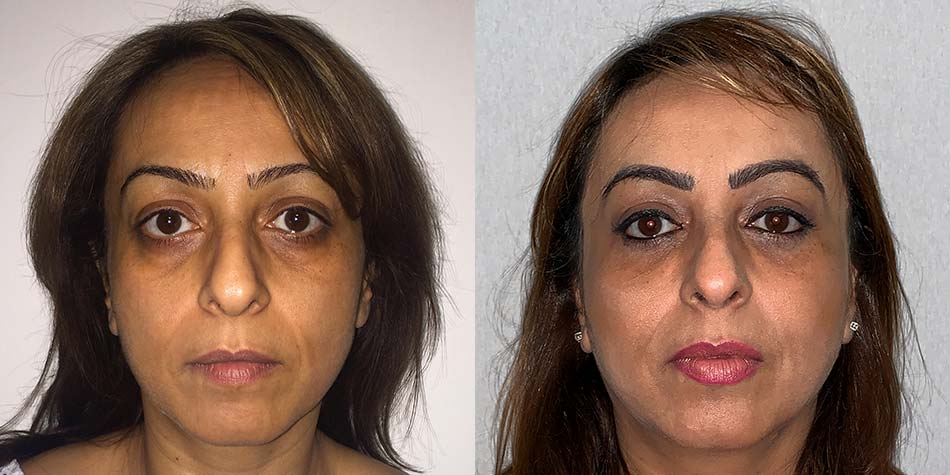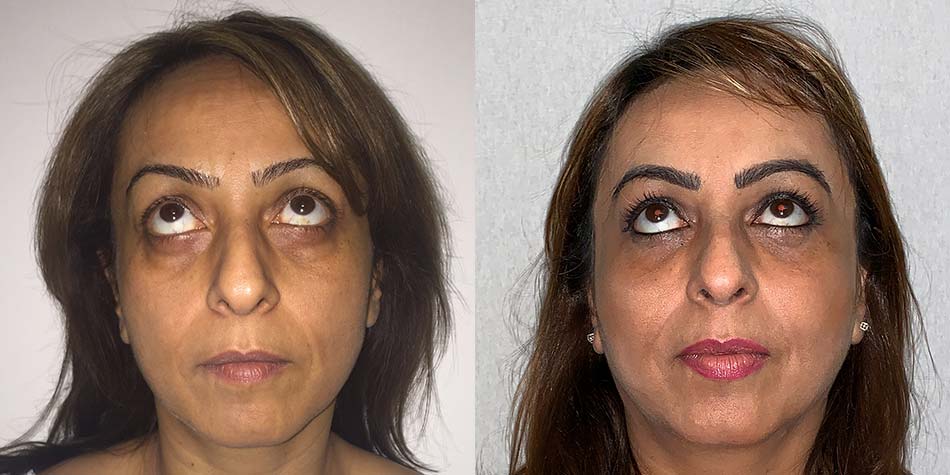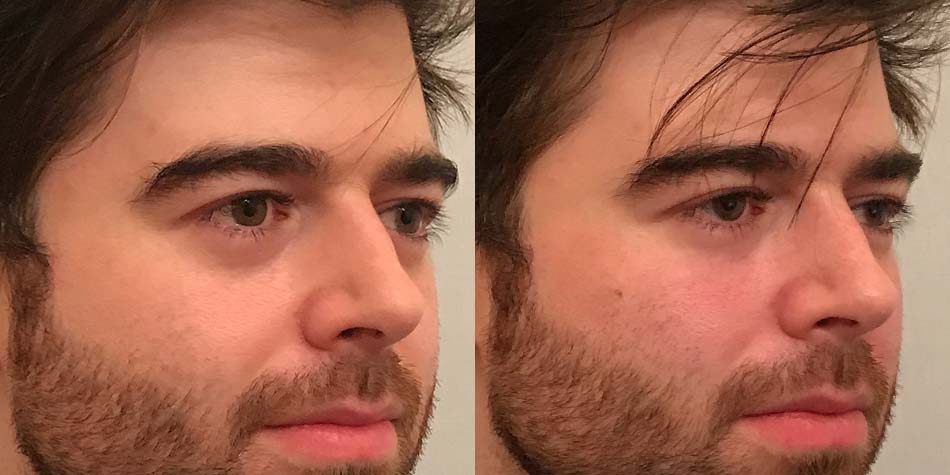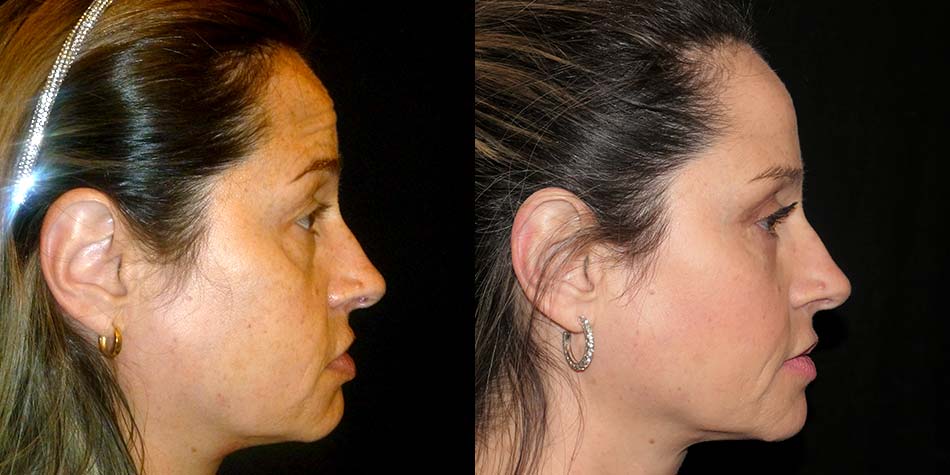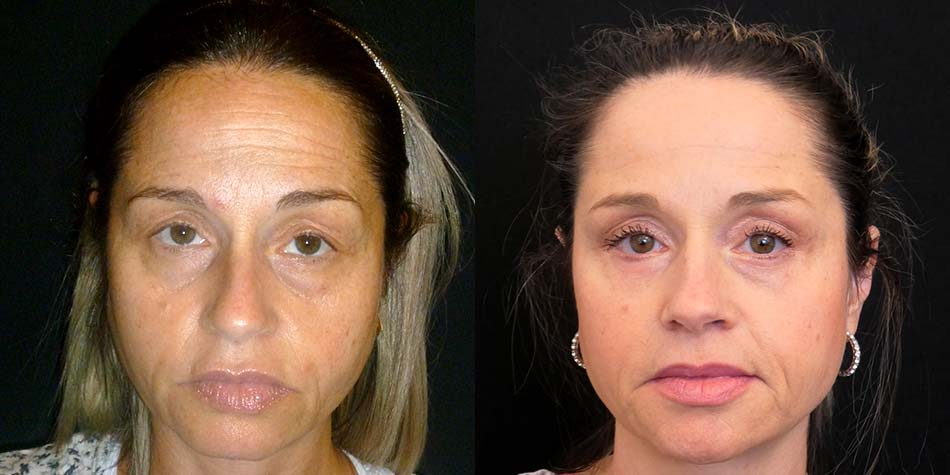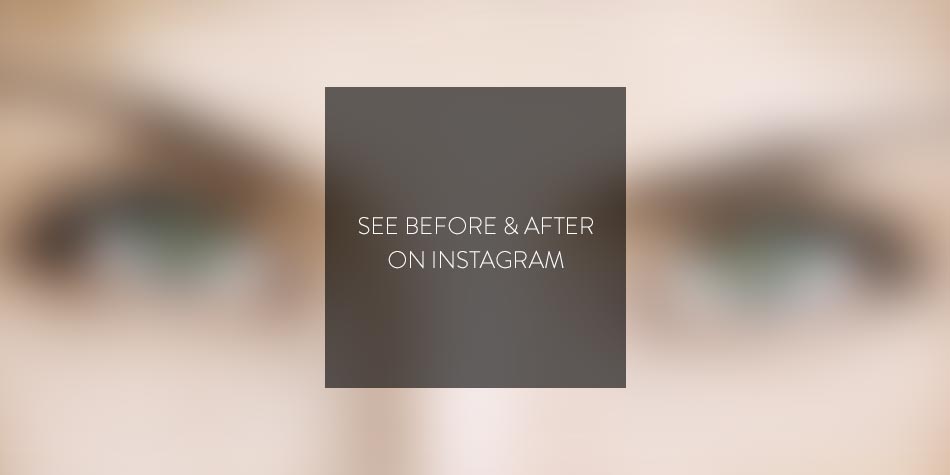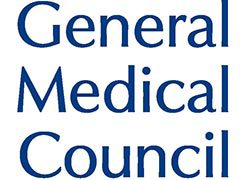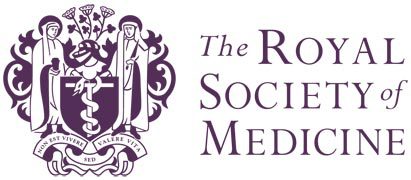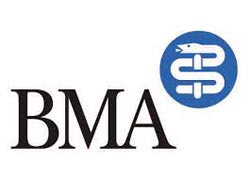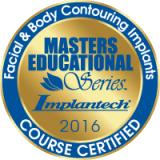Eye Bag Removal
An eyelid surgery or blepharoplasty is a cosmetic procedure that aims to make the eye (or periorbital) area appear more youthful by removing excess skin, muscle or fat from the upper or lower eyelids.
Eyes are probably the centre of our expressiveness so when they look tired or “not in a good shape”, the overall outlook is poor. When concentrated on the area below the eye, the blepharoplasty procedure is sometimes known as eye bag removal. Eyelid surgery is the only solution to rectify in one stage all layers: skin, fat and muscle bulging.
Dr Cotrufo worked in the Maxillofacial Unit at the University College Hospital of London (UCLH) for three years where he managed the most complex cases of traumas and cancer deformities of the facial and periorbital area. He is very skilled in managing soft tissues in the periorbital area.
- Read More
Dr Cotrufo performs lower blepharoplasties with transcutaneous (through the skin) or trans-conjunctival approaches (from the inside of the lower eyelid without any skin incision). He often recommends further procedures to enhance the results of eyelid surgery such as periorbital reshaping: fat injection or malar implants are top recommendations. It is essential to have at least two or three consultations before proceeding with surgery. Dr Cotrufo’s advice is always to seek a second and third opinion with other “independent” practitioners before proceeding with any facial surgery.
WHY CHOOSE BLEPHAROPLASTY
Age impacts the eyes in many ways, giving the appearance of tiredness even when you feel fully alert, sometimes making you look older than you feel. While it won’t remove wrinkles or crow’s feet, blepharoplasty can open up the eye area, helping you to look and feel revived and youthful.
Sometimes the problem is at the level of the epidermis (superficial skin). In that case the solution is not surgical but a deep resurfacing with either fractionated laser or CO2. If young patients have obvious deposit of fat (white spots or yellow stains) over the upper and lower eyelid, it will be useful to check on the cholesterol level before planning any procedure.
WHAT CAN BLEPHAROPLASTY ACHIEVE?
-
Correct drooping or hooded upper eyelids
-
Remove puffy lower lids, known as eye bag removal
-
Give the eye area a more fresh and youthful appearance
-
Help you look more awake and younger
-
Correct asymmetry
-
Improve specific muscle weakness and achieve better symmetry.
IS THERE AN EYELIFT ALTERNATIVE?
Blepharoplasty is often combined with other facial plastic surgery procedures such as a brow lift or facelift. For the correction of crow’s feet or wrinkles, you may select non-surgical treatments in place of, or alongside blepharoplasty, such as fillers. These are simpler and minimally-invasive procedures.
The main difference between surgical and non-surgical eyelid solutions is that, with the latter option, you might need more treatments to address selectively tissue-by-tissues. Non-surgical treatments are always targeting a specific tissue. For example, Fraxionated laser to improve skin irregularities and texture, Fillers to restore the cheek, eyebrows or jawline volume.
Initially, this might result in excessive costs and waste of energy: ultimately this can produce similar (although inferior) results with extremely lower risks of complications.
During your consultation, Dr Cotrufo will be able to advise which treatment(s) will be most appropriate for your specific aims. The balance between risks and benefits is crucial when treating the eyelid and the face. Our advice is to explore, first, the less invasive solution and you should expect this line of recommendation when visiting Dr Cotrufo.
WHAT TO EXPECT BEFORE BLEPHAROPLASTY?
We want your plastic surgery experience to be as comfortable and relaxing as possible, which makes great communication between you and your surgeon essential. This starts with your personal consultation, where you will be able to discuss your individual circumstances. Preparation to your eyelid surgery is essential as much as (or more if you are above 45 years old) the technical excellence provided by your plastic surgeon.
DURING YOUR CONSULTATION YOU WILL:
-
Explain your reasons for seeking eyelift surgery and score it between 0 to 10 (scale of relevance).
-
Be able to ask Dr Cotrufo questions about the blepharoplasty techniques, recovery, complications and associated procedure.
-
Have a full health evaluation.
-
Undergo an assessment of your eyelids, sight and surrounding area: you might be referred to another “independent consultant” for a second opinion. Their main interest could be ophthalmology and/or periorbital surgery. You are free to select your second and third consultant but Dr Cotrufo will always be there to suggest and discuss outcomes from other consultations. “No obligation” means that you will be free to proceed with any other consultant you choose. Dr Cotrufo will assist you in any way with his written advice and communication with your selected surgeon, the target is your happiness.
-
Discuss the various surgical and non-surgical options along with their risks and possible complications.
AS YOUR PROCEDURE APPROACHES:
You may be asked to make small alterations to your lifestyle or to avoid particular activities and medications: this is to ensure that you are in the best possible health for surgery.
This may include:
-
Taking a blood test or other medical tests.
-
Stopping smoking.
-
Adjusting or taking certain medications.
-
Avoiding aspirin, herbal supplements and anti-inflammatory drugs.
-
Refraining from drinking alcohol.
-
Avoiding overexposure to the sun, particularly to the eye area.
-
Committing not to make significant changes to your diet.
Patients undergoing general anesthesia will be given fasting instructions to follow (usually nothing by mouth six (6) hours before surgery).
THE BLEPHAROPLASTY PROCEDURE:
-
Blepharoplasty surgery usually takes 1-3 hours depending on the extent of work being carried out and type of anaesthesia.
-
An incision is made into the natural lines of your upper and lower eyelids; these may extend into the inner and outer corners of your eyes.
-
Excess fatty tissue, skin and muscle is then removed or reshaped.
-
The incisions are closed with very fine sutures, usually a mixture of self-dissolving and not: Dr Cotrufo invites his patients at one (1) week after surgery to remove the most superficial sutures and plan the next follow up appointment.
AFTER YOUR BLEPHAROPLASTY:
Following your surgery, you will usually be able to return home the same or next day.
After that:
-
Start walking around as soon as possible.
-
Your eyes will need lubricating with ointment and will have fine tape applied around them.
-
In the first 24-72 hours after surgery, your eyes will feel puffy with tight eyelids.
-
You should be able to shower with warm water one week after surgery: until then dressing need to be clean and dry.
-
Swelling and bruising will peak about 2-3 days after surgery and then begin to subside.
-
Most bruising and swelling will be gone 7-14 days after surgery.
-
You will need to keep your head elevated for the first few days (2-4) after surgery and we will provide cold compresses straight after surgery/treatment to avoid excessive swelling and relieve discomfort.
-
You will clean your eyes as directed by the nursing staff and may need eye drops (saline 0.9%).
-
The dressings and stitches will usually be removed 5-7 days after surgery.
-
You should not wear contact lenses until advised.
-
You should avoid steam baths, saunas and sunbathing for several months and be gentle washing your face.
-
You will need to avoid all strenuous activities for up to 1 month.
-
You should be able to resume normal activities after 7-10 days.
-
Full recovery can take 6 weeks to 6 months. Revision surgery usually takes much longer to recover and the quality of the scar is unpredictable.
-
You will need to attend aftercare appointments with Dr Cotrufo very carefully. He will monitor your progress and answer any questions you may have.
STILL HAVE QUESTIONS ABOUT EYELID SURGERY?
Deciding whether blepharoplasty is right for you is a very personal decision. If you would like more information about the procedure and whether you are suitable for this type of surgery, you can book a personal consultation with our clinic’s surgeon, Dr Cotrufo. He is an expert plastic surgeon who specialises in facial surgical procedures such as eyelid surgery. To organise an appointment with Dr Cortrufo at our Harley Street clinic, please call our clinic on 0207 8732330.
Eye Lid Correction
An eyelid surgery or blepharoplasty is a cosmetic procedure that aims to make the eye (or periorbital) area appear more youthful by removing excess skin, muscle or fat from the upper or lower eyelids.
Eyes are probably the centre of our expressiveness so when they look tired or “not in a good shape”, the overall outlook is poor. Eyelid surgery is the only solution to rectify in one stage all layers: skin, fat and muscle bulging.
Dr Cotrufo worked in the Maxillofacial Unit at the University College Hospital of London (UCLH) for three years where he managed the most complex cases of traumas and cancer deformities of the facial and periorbital area. He is very skilled in managing soft tissues in the periorbital area.
- Read More
WHY CHOOSE BLEPHAROPLASTY?
Age impacts the eyes in many ways, giving the appearance of tiredness even when you feel fully alert, sometimes making you look older than you feel. While it won’t remove wrinkles or crow’s feet, blepharoplasty can open up the eye area, helping you to look and feel revived and youthful.
Upper blepharoplasty: this procedure is the main solution to correct the excess of skin, excessive fat bulging or correct asymmetry in the position of the upper eyelid due to a weakness of the levator muscle or to excessive length of its aponeurosis (fibrous insertion into the tarsal plate).
This procedure is also used in facial palsy to restore upper eyelid asymmetry and insert “gold weight” to create a more symmetric movement of the upper eyelid.
Upper blepharoplasty approach consists of a round-horizontal incision that follows the shape of the upper eyelid edge (at the eyelashes). This is usually positioned where the sulcus is so that the resultant scar isn’t obvious.
A most recent technique of upper eyebrow suspension is based on upper blepharoplasty approach and insertion of a “suspension implants” on the upper orbital margin. The device is called Endotine and it is supposed to be self-dissolving.
WHAT CAN BLEPHAROPLASTY ACHIEVE?
-
Correct drooping or hooded upper eyelids
-
Remove puffy lower lids, known as eye bag removal
-
Give the eye area a more fresh and youthful appearance
-
Help you look more awake and younger
-
Correct asymmetry
-
Improve specific muscle weakness and achieve better symmetry.
IS THERE AN EYELIFT ALTERNATIVE?
Blepharoplasty is often combined with other facial plastic surgery procedures such as a brow lift or facelift. For the correction of crow’s feet or wrinkles, you may select non-surgical treatments in place of, or alongside blepharoplasty, such as fillers. These are simpler and minimally-invasive procedures.
The main difference between surgical and non-surgical eyelid solutions is that, with the latter option, you might need more treatments to address selectively tissue-by-tissues. Non-surgical treatments are always targeting a specific tissue. For example, Fraxionated laser to improve skin irregularities and texture, Fillers to restore the cheek, eyebrows or jawline volume.
Initially, this might result in excessive costs and waste of energy: ultimately this can produce similar (although inferior) results with extremely lower risks of complications.
During your consultation, Dr Cotrufo will be able to advise which treatment(s) will be most appropriate for your specific aims. The balance between risks and benefits is crucial when treating the eyelid and the face. Our advice is to explore, first, the less invasive solution and you should expect this line of recommendation when visiting Dr Cotrufo.
WHAT TO EXPECT BEFORE BLEPHAROPLASTY?
We want your plastic surgery experience to be as comfortable and relaxing as possible, which makes great communication between you and your surgeon essential. This starts with your personal consultation, where you will be able to discuss your individual circumstances. Preparation to your eyelid surgery is essential as much as (or more if you are above 45 years old) the technical excellence provided by your plastic surgeon.
DURING YOUR CONSULTATION YOU WILL:
-
Explain your reasons for seeking eyelift surgery and score it between 0 to 10 (scale of relevance).
-
Be able to ask Dr Cotrufo questions about the blepharoplasty techniques, recovery, complications and associated procedure.
-
Have a full health evaluation.
-
Undergo an assessment of your eyelids, sight and surrounding area: you might be referred to another “independent consultant” for a second opinion. Their main interest could be ophthalmology and/or periorbital surgery. You are free to select your second and third consultant but Dr Cotrufo will always be there to suggest and discuss outcomes from other consultations. “No obligation” means that you will be free to proceed with any other consultant you choose. Dr Cotrufo will assist you in any way with his written advice and communication with your selected surgeon, the target is your happiness.
-
Discuss the various surgical and non-surgical options along with their risks and possible complications.
Brow Lift
The area around and above the eyes often shows the effects of ageing prominently. Furrowed and drooping brows and frown lines can make you appear more tired or older than you feel. An eyebrow or forehead lift seeks to correct these problems, restoring definition to the face.
Why choose a brow lift?
Every year men and women of all ages choose to have brow lifts to correct lines and furrows that can make them appear angry, tired or sad.
- Read More
WHAT CAN A BROW OR FOREHEAD LIFT ACHIEVE?
-
Corrects dropping brows
-
Improves horizontal lines and furrows that can make you appear angry, sad or tired
-
Smoothing of the forehead to minimise lines
-
Correction of inherited conditions such as low or heavy brows
WHAT ARE THE ALTERNATIVES TO BROW LIFT?
There may be other surgical procedures that target your problem areas more accurately and Dr Cotrufo will be able to advise you of your options during a consultation. For example, some people who explore the prospect of upper eyelid surgery find that a forehead lift is better suited to their aims. In addition, you may decide to combine brow lift surgery with other procedures such as blepharoplasty (an eye lift) or a facelift.
BEFORE YOUR BROW LIFT
A relaxed and comfortable surgery experience starts with good communication between you and your surgeon. During your consultation, you will be able to meet with Dr Cotrufo, discuss your situation and ask him questions.
DURING YOUR BROW LIFT CONSULTATION, YOU WILL:
-
Have the opportunity to explain your reasons for seeking brow lift surgery
-
Be given the opportunity to pose questions to Dr Cotrufo
-
Undergo a health evaluation
-
Have a full assessment of your brow and forehead area
-
Discuss the options that best suit your needs
-
Discuss the risks and benefits of brow lift in addition to costs and timescales
In the weeks leading up to your procedure and the days immediately prior, you may be asked to make some small changes to your lifestyle or to avoid particular medications or activities.
This may include:
-
Taking a blood test or other medical tests
-
Stopping smoking
-
Adjusting or taking certain medications
-
Avoiding aspirin, herbal supplements and anti-inflammatory drugs
-
Refraining from drinking alcohol
-
Avoiding overexposure to the sun, especially to the head and face
-
Committing not to make stringent changes to your diet
Those undergoing general anaesthetic will be given fasting instructions to follow.
THE OPEN BROW LIFT PROCEDURE:
-
A brow lift or forehead lift procedure usually lasts several hours
-
The type of anaesthesia will affect the time required
-
A coronal incision is made in a headphone-shaped pattern behind the hairline, patients with lesser hair may have a mid-scalp incision
-
The forehead skin is lifted and the muscles and underlying tissues are smoothed
THE ENDOSCOPIC FOREHEAD LIFT:
-
This follows most of the same steps as an open brow lift but with differing incisions
-
3-5 short scalp incisions less than an inch in length are made along the brow line, the endoscope is then inserted through one of the incisions
-
An instrument is inserted through the incisions, lifting the skin and the muscles to remove or alter underlying tissues
-
The eyebrows may also be lifted and secured into a higher position by sutures
AFTER YOUR BROW LIFT
Upon discharge, we recommend a friend or relative drive you home and care for you should you need assistance during your brow lift recovery.
After that:
-
You will need to keep your head elevated for a few days after surgery
-
Bandages can usually be removed 1-5 days after the procedure
-
You will be able to shower in warm water the second day after surgery
-
Start walking as soon as possible
-
Stitches and clips can generally be removed 7-14 days after surgery
-
Swelling and bruising will start to subside after 7-14 days
-
Strenuous activity should be avoided for 1 month
-
As your scars heal, they may appear to worsen for the first few months before lightening and flattening
-
Do not use a hairdryer, colour or pull or wrap your hair for several months
-
Avoid steam baths, saunas and sunbathing for several months
-
Camouflage makeup can mask bruising should you need it
-
You will need to attend scheduled aftercare appointments with Dr Cortufo, who will monitor your progress
STILL HAVE BROW LIFT QUESTIONS THAT YOU’D LIKE ANSWERED?
Expert in plastic surgery and reconstructive microsurgery, Dr Cotrufo, specialises in carrying out facial procedures such as brow lifts. If you have any further questions about the procedure, your suitability for surgery or the aftercare you can expect to receive should you choose to undergo a brow or forehead lift at his clinic, please call 0207 873 2330 to organise a personal consultation.
© 2023 Dr Stefano Cotrufo | All rights reserved
© 2023 Dr Stefano Cotrufo | All rights reserved
